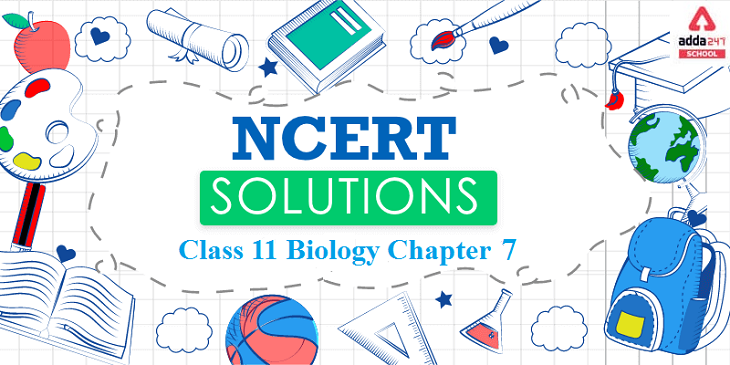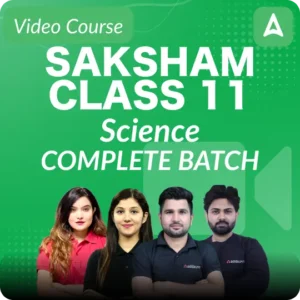NCERT Solutions for Class 11 Biology Chapter 7 in English
Adda 247 provides NCERT Solutions for Class 11 Biology chapter 7 which is for the students who want to go ahead in life and achieve great marks in their examinations. The NCERT Solutions for Class 11 Biology chapter 7 are provided by the teachers who are experts in their subjects. The solutions are set according to the rules formulated by the NCERT and in the language that can be understood by every student. By these reading, the solutions students can build up a strong base easily. The NCERT class 11 Biology solutions cover chapters 1 to 22 with the important questions and the answers in a detailed way.
Examinations can be threatening for some people, a proper learning of the concepts is the key to crack the examination. Students rely on the solutions of the NCERT provided by Adda 247. The solutions are formulated by the experts of the subjects who have tremendous knowledge in their subjects.
These NCERT Solutions help the students to get familiarized with the textbooks. The students can access the solutions anywhere while browsing the web easily. The solutions are very precise and accurate.
NCERT Solutions Class 11 Biology Chapter 7 – Structural organization in Animals
The chapter provides information about Structural organization in animals. Body of an animal is formed of several kinds of cells. There are about 200 different types of specialized cells in the human body. The cells of one or more kinds are arranged together in a characteristic manner and cooperate to perform a specific role. Such a group of cells is called a tissue. The cell of a tissue may secrete between them a non-living intercellular material. Thus, a tissue may be defined as a group of one or more types of cells having a similar origin and specialized for a specific function or functions along with the intercellular material.
Features of the NCERT Solutions for Class 11 Biology Chapter 7- Structural organization in Animals
NCERT Solutions have been answered based on the important information on the question.
- The columns are used wherever necessary.
- Solutions are solved point wise and accurately answered point to point.
Important Questions Ncert Solutions for Class11 Biology Chapter 7- Structural organization in animals
Question 1. Answer in one word or one line.
(i) Give the common name of Periplanata americana.
(ii) How many spermathecae are found in earthworm?
(iii) What is the position of ovaries in cockroach?
(iv) How many segments are present in the abdomen of cockroach? (v) Where do you find Malpighian tubules?
Answer: The common name of Periplanata americana is the American cockroach.
(ii) Four pairs of spermathecae are present in earthworms. They are located between sixth and the ninth segments. They help in receiving and storing the spermatozoa during copulation.
(iii) In a cockroach, the pair of ovaries is located between 12th and 13th abdominal segments.
(iv) In both sexes, the abdomen of a cockroach consists of ten segments.
(v) Malphigian tubules are main excretory organs of cockroaches. They form a part of the alimentary canal.
Question 2. Answer the following:
(i) What is the function of nephridia?
(ii) How many types of nephridia are found in earthworm based on their location?
Answer: Nephridia are segmentally arranged excretory organs present in earthworms. (ii) On the basis of their location, three types of nephridia are found in earthworms. They are: Septal nephridia: These are present on both sides of the inter-segmental septa behind the 15th segment. They open into the intestines. Integumentary nephridia: These lie attached to the body wall from the third segment to the last segment, which opens on the body surface. Pharyngeal nephridia: These are present as three paired tufts in fourth, fifth, and sixth segments.
Question 5. Distinguish between the following:
(a) Prostomium and peristomium
(b) Septal nephridium and pharyngeal nephridium
Answer:
| Prostomium | Peristomium |
| It is the dorsal lobe which is located on the ventral mouth. | It is the first segment or earthworm having a ventral mouth. |
| It overhangs the mouth of an earthworm. | It surrounds the opening of the mouth. |
| Septal nephridium | Pharyngeal nephridium |
| It is present on both the sides of inter-segmental septa. | They are present as three paired tufts in the fourth, fifth and sixth segments. |
| They open in the intestine. | They are closed. |
Question 6. What are the cellular components of blood?
Answer: It has four main components: plasma, red blood cells, white blood cells and platelets. Blood has many different functions, including: transporting oxygen and nutrients to the lungs and tissues, forming blood clots to prevent excess blood loss.
Question 7. What are the following and where do you find them in animal body.
(a) Chondriocytes
(b) Axons
(c) Ciliated epithelium
Answer:
(a) Chondrocytes – Chondrocytes are the only cells found in cartilage. They are present in spaces called
lacunae and they produce and maintain the matrix of cartilage. Bending ability of cartilage is due to
chondrocytes. Cartilage is present at tip of nose, pinna of ear, epiglottis etc.
(b) Axon – Axon is one of the processes of neuron, which is the structural and functional unit of
nervous system. The part of cyton – n’here axon arises is axon hillock and axon ends in group of
branches called terminal arborizations. It conducts impulses away from the cyton. Neurons (nerve cells)
are present in brain and spinal cord.
(c) Ciliated epithelium – If the columnar or cuboidal cells bear cilia on their free surface they are called
ciliated epithelium. Their function is to move particles or mucus in a specific direction over the
epithelium. They are mainly present in the inner surface of hollow organs like bronchioles and
Fallopian tube.
Question 8. Describe various types of epithelial tissues with the help of labelled diagrams
Answer:
(a) Simple epithelium: It is the single layer of cells which are in direct contact with the basement membrane. Simple epithelium is further subdivided into the following types:
(i) Simple squamous epithelium: It consists of a single layer of flat cells with irregular boundaries. Simple squamous epithelium is mostly found in the walls of the blood vessels and in the lining of alveoli.
(ii) Simple cuboidal epithelium: It consists of a single layer of cube-like cells and is present in regions where secretion and absorption of substances take place such as the proximal convoluted tubule region of the nephron.
iii) Simple columnar epithelium: This epithelium is formed by a single layer of tall, slender cells with their nuclei present at the base of the cells. These generally possess microvilli on the free surfaces. Columnar epithelium forms the lining of the stomach and intestines. The major function of simple columnar epithelium is secretion and absorption.
(iv) Ciliated epithelium: It consists of columnar or cuboidal cells with cilia on their free surfaces. They are present in bronchioles and oviducts from where they direct mucus and eggs in specific directions.
(v) Glandular epithelium: These are columnar or cuboidal cells involved in the secretion of substances. Glands are of two types, unicellular glands (goblet cells of the alimentary canal) and multicellular glands (salivary glands). They can be classified as exocrine (ductless glands) and endocrine glands (duct glands) based on the method through which they release enzymes.
(b) Compound epithelium: When the simple epithelium is consists of many layers of cells, it is called compound epithelium. The compound epithelium is involved mainly in the function of providing protection and has a limited role in secretion and absorption. Examples of compound epithelium include the dry surface of the skin or moist inner lining of the buccal cavity, pharynx, pancreatic ducts, and the inner lining of ducts of salivary glands.
(iii) Simple columnar epithelium: This epithelium is formed by a single layer of tall, slender cells with their nuclei present at the base of the cells. These generally possess microvilli on the free surfaces. Columnar epithelium forms the lining of the stomach and intestines. The major function of simple columnar epithelium is secretion and absorption.
(iv) Ciliated epithelium: It consists of columnar or cuboidal cells with cilia on their free surfaces. They are present in bronchioles and oviducts from where they direct mucus and eggs in specific directions.
(v) Glandular epithelium: These are columnar or cuboidal cells involved in the secretion of substances. Glands are of two types, unicellular glands (goblet cells of the alimentary canal) and multicellular glands (salivary glands). They can be classified as exocrine (ductless glands) and endocrine glands (duct glands) based on the method through which they release enzymes.
(b) Compound epithelium: When the simple epithelium is consists of many layers of cells, it is called compound epithelium. The compound epithelium is involved mainly in the function of providing protection and has a limited role in secretion and absorption. Examples of compound epithelium include the dry surface of the skin or moist inner lining of the buccal cavity, pharynx, pancreatic ducts, and the inner lining of ducts of salivary glands.
Question 9. Distinguish between
(a) Simple epithelium and compound epithelium
(b) Cardiac muscle and striated muscle
(c) Dense regular and dense irregular connective tissues (d) Adipose and blood tissue
(e) Simple gland and compound gland
Answer:
(a) Simple epithelium and compound epithelium
| Simple epithelium | Compound epithelium |
| It is composed of a single layer of cells. | It consists of two or more cell layers. |
| It functions as a lining for body cavities, ducts and tubes. | It is protective in function like our skin. |
(b) Cardiac muscle and striated muscle
| Cardiac muscle | Striated muscle |
| It occurs only in the wall of the heart. | It occurs in the body wall, limb, tongue, pharynx, etc. |
| They are short and cylindrical with truncate ends. | They are long and cylindrical with blunt ends. |
| They have nerve supply from brain and autonomous nervous system. | They have nerve supply from central nervous system. |
(c) Dense regular and dense irregular connective tissues
| Dense regular | Dense irregular |
| Collagen fibres are present in rows between many parallel bundle of fibres. For example, tendons. | Fibroblasts and many fibres are present that are oriented. For example, cartilage, bones and blood. |
(d) Adipose and blood tissue
| Adipose tissue | Blood |
| It is present mainly beneath the skin. | It flows within the blood vessels and has RBCs |
| It stores extra fat and excess nutrients. | It helps in transport of various substances. |
(e) Simple gland and compound gland
| Simple gland | Compound gland |
| The glands have single, unbranched duct. | The glands have branched system to ducts. |
| These may be simple, tubular glands, simple coiled tubular glands and alveolar glands. | These may be compound tubular glands, compound alveolar glands and compound tubuloalveolar glands. |
Question 10. Mark the odd one in each series: (a) Areolar tissue; blood; neuron; tendon
(b) RBC; WBC; platelets; cartilage
(c) Exocrine; endocrine; salivary gland; ligament (d) Maxilla; mandible; labrum; antennae
(e) Protonema; mesothorax; metathorax; coxa
Answer:
Areolar tissue, blood, and tendons are examples of connective tissues. Neuron is an example of neural tissue.
(b) RBCs, WBCs, and platelets are the three most important components of blood. Cartilage is
therefore, the odd one out.
(c) Exocrine, endocrine, and salivary glands are examples of simple glandular epithelium. Ligament is a connective tissue.
(d) Maxilla, mandible, and labrum are mouthparts of a cockroach. Antennae, on the other hand, are
present in the head region of cockroaches.
(e) Protonema forms the developmental stage in the life cycle of a moss. Mesothorax, metathorax, and
coxa are parts or segments present in the legs of a cockroach.
Question 11. Match the terms in column I with those in column II:
| Column I | Column II |
| (a) Compound epithelium | (i) Alimentary canal |
| (b) Compound eye | (ii) Cockroach |
| (c) Septal nephridia | (iii) Skin |
| (d) Open circulatory system | (iv) Mosaic vision |
| (e) Typhlosole | (v) Earthworm |
| (f) Osteocytes | (vi) Phallomere |
| (g) Genitalia | (vii) Bone |
Solution:
| Column I | Column II |
| (a) Compound epithelium | (iii) Skin |
| (b) Compound eye | (iv) Mosaic vision |
| (c) Septal nephridia | (v) Earthworm |
| (d) Open circulatory system | (ii) Cockroach |
| (e) Typhlosole | (i) Alimentary canal |
| (f) Osteocytes | (vii) Bone |
| (g) Genitalia | (vi) Phallomere |
Question 12. Mention briefly about the circulatory system of earthworm
Answer: Earthworm exhibits a closed type of blood vascular system. This type of blood vascular
system consists of blood vessels, capillaries and heart. Due to closed circulatory system, blood is
confined to the heart and blood vessels. Contractions of the body keep blood circulating in one
direction. Smaller blood vessels supply the gut, nerve cord, and the body wall. Blood glands are present
on the4th, 5th and 6th segments. They produce blood cells and haemoglobin, which is dissolved in
blood plasma. Blood cells are phagocytic in nature. Earthworms lack specialised breathing devices.
Respiratory exchange occurs through the moist body surface directly into the blood stream.










 CUET UG 2026 Online Registration Started...
CUET UG 2026 Online Registration Started...
 CUET 2026 Free Batches Launched by CUET ...
CUET 2026 Free Batches Launched by CUET ...
 CBSE Date Sheet 2026 for Class 10 & ...
CBSE Date Sheet 2026 for Class 10 & ...














